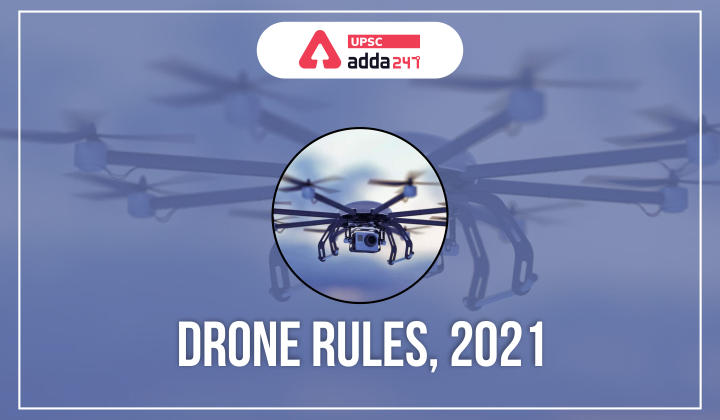Table of Contents
Liberalized Drone Rules, 2021- Context
- Recently, the union government has decided to repeal the Unmanned Aircraft Systems (UAS) Rules, 2021, and replace the same with the liberalized Drone Rules, 2021.
- Drone Rules 2021 are based on the principles of trust, self-certification and non-intrusive monitoring.

Get free video for UPSC CSE preparation and make your dream of becoming an IAS/IPS/IRS a reality
Liberalized Drone Rules, 2021- Key features
- Designed to balance the need to catalyze super-normal growth while balancing safety and security considerations.
- Abolition of Multiple Approval: for example, unique authorization number, unique prototype identification number, certificate of manufacturing and airworthiness, etc.
- The number of forms has also been reduced from 25 to 5.
- Rationalization of fee: Quantum of fee reduced to nominal levels and delinked with the size of the drone. For Instance-
- The fee for remote pilot license fee has been reduced from INR 3000 (for large drones) to INR 100 for all categories of drones and is valid for 10 years.
- Development of a Digital sky platform as a user-friendly single-window system: There will be minimal human interface and most permissions will be self-generated.
- Interactive airspace map with green, yellow and red zones shall be displayed on the digital sky platform within 30 days of publication of these rules.
- Manufacturers and importers may generate their drones’ unique identification number on the digital sky platform through the self-certification route.
- Easier process specified for transfer and deregistration of drones through the digital sky platform.
- No permission required in green zones: Green-zone means the airspace upto-
- A vertical distance of 400 feet or 120 metre that has not been designated as a red zone or yellow zone in the airspace map; and
- A vertical distance of 200 feet or 60 metre above the area located between a lateral distance of 8 and 12 kilometre from the perimeter of an operational airport.
- Yellow zone was reduced from 45 km to 12 km from the airport perimeter.
- Liberalized License Regime:
- No remote pilot license is required for micro drones (for non-commercial use) and nano drones.
- No requirement for security clearance before issuance of any registration or license.
- No requirement of Type Certificate, unique identification number, and remote pilot license by R&D entities operating drones in own or rented premises, located in a green zone.
- Promoting Investment in the Drone sector:
- Restriction on foreign ownership in Indian drone companies has been lifted.
- Import of drones to be regulated by DGFT.
- Requirement of import clearance from DGCA abolished.
- Drone corridors will be developed for cargo deliveries.
- Coverage of drones under Drone Rules, 2021 increased from 300 kg to 500 kg. This will cover drone taxis also.
- Role of DGCA:
- DGCA shall prescribe drone training requirements, oversee drone schools and provide pilot licences online.
- Remote pilot licence to be issued by DGCA within 15 days of the pilot receiving the remote pilot certificate from the authorized drone school through the digital sky platform.
- Standard operating procedures (SOP) and training procedure manuals (TPM) will be prescribed by DGCA on the digital sky platform for self-monitoring by users. No approvals are required unless there is a significant departure from the prescribed procedures.
- Liberalizing Type certification:
- Testing of drones for issuance of Type Certificate to be carried out by Quality Council of India or authorized testing entities.
- Type Certificate required only when a drone is to be operated in India. Importing and manufacturing drones purely for exports are exempt from type certification and unique identification numbers.
- Nano and model drones (made for research or recreation purposes) are exempt from type certification.
- Provisions for Security and Safety:
- Maximum penalty for violations reduced to INR 1 lakh.
- Safety and security features like ‘No permission – no takeoff’ (NPNT), real-time tracking beacon, geo-fencing, etc. to be notified in the future. A six-month lead time will be provided to the industry for compliance.
- Drone promotion council: to be set up by Government with participation from academia, startups and other stakeholders to facilitate a growth-oriented regulatory regime.
Key Significance of the Drones (UAS)
- Potential to offer tremendous benefits to almost all sectors of the economy like-
- Agriculture,
- Mining,
- Infrastructure,
- Surveillance,
- Emergency response,
- Transportation,
- Geo-spatial mapping,
- Defence, and law enforcement, etc.
- Creators of employment and economic growth: due to their reach, versatility, and ease of use, especially in India’s remote and inaccessible areas.
- Potential to be a global drone hub by 2030: In view of its traditional strengths in innovation, information technology, frugal engineering, and huge domestic demand, India has the potential to be a global drone hub by 2030.



 TSPSC Group 1 Question Paper 2024, Downl...
TSPSC Group 1 Question Paper 2024, Downl...
 TSPSC Group 1 Answer key 2024 Out, Downl...
TSPSC Group 1 Answer key 2024 Out, Downl...
 Cabinet Ministers of India 2024, New Cab...
Cabinet Ministers of India 2024, New Cab...







